I have a bad habit of buying unusual flour during my travels. I’ve carted five-pound bags of Southern White Lily flour across the Mississippi River to California. I wanted to know how it would perform in steamed bao dough! (Not bad, brighter white than regular all-purpose.) I’ve purchased “Hong Kong” flour in Singapore and “dumpling” flour in Shanghai. I’m always on the lookout for something out of the ordinary because I'm a curious cook. Will a special flour up my Asian dumpling game?
That’s why I couldn’t resist shelling out $8 for the above bag of special dumpling flour made by Shenzhen Southseas Grains Industries. Yes, it came from China and no, the URL on the bag didn’t lead anywhere, BUT the high price and ‘export quality’ promised something special. (I always wonder about the claims of an ingredient being of export quality because that infers that locals get the bad stuff.)
To test drive the flour, I did a side by side comparison with my go-to unbleached Gold Medal all-purpose flour (plain flour). Here is what I found out.
Texturally, the special dumpling flour was strange. I didn’t expect the Chinese dumpling flour to look different than the Gold Medal. When I scooped it out of the bag, it was powdery and fine almost like rice flour. The Gold Medal felt and looked more fluffy. It fell onto my cutting board with little clumps in the mound.
Dough consistency and color were also interesting. According to the label, the Chinese flour contained dough improver to strengthen it (make it more elastic) and normal stuff to enrich the flour (calcium, zinc, iron, vitamin B1, B2, B3, and folic acid). Most wheat grown in China is softer than what we have in the United States. The protein level is lower so dough made with the flour tends to have less elasticity. Dough improver fixes that.
When I made my normal dough from the Chinese flour, the flour smelled chemically at first and then dissipated. Because of the additive, the dough was stiffer than that made with the Gold Medal flour. The color was also brighter, whiter – a preference in many parts of Asia. I suppose it’s a marker of modern production achievements.
Dough workability was illuminating. When I went to form wrappers and shape dumplings from the dough, it felt more PlayDoh like than what I was used to with Gold Medal flour, which is soft, malleable, and a tad stretchy. The Chinese dumpling flour dough felt more stiff and smooth.
For years, I’d wondered how Chinese dumpling makers were able to make distinctive pleats and folds. This flour gave me insights as the wrapper felt like I could practically sculpt it. Not exactly like the wheat starch dough for har gow but it yielded wrappers that felt different in your hand as you worked the dough.
I’m not sure if you can see the difference in the photo above. Dumplings made from the Chinese flour are definitely whiter than the Gold Medal ones; the pleats are just a tad better defined on the Chinese flour ones. Does that make the flour a game changer? I cooked some as pot stickers to taste.
In the pan, dumplings made with the Chinese flour took up more water during pan-frying. Given the dough’s general stiffness, I used more water than usual when pan-frying to ensure that the end result would be chewy-tender, the way I like my pot stickers. The flavor of the Chinese flour dumplings was slightly flat, but fine overall.
I cooked the two kinds separately and also in a pan together.
Dumplings made with Gold Medal flour dough had a rustic look due to their unbleached state. They were peasant dumpling cousins to their whiter Chinese dumplings. The flavor of the unbleached wrapper was good. The wrapper had something to say and complemented the filling nicely.
Colorwise, Gold Medal flour may not please some dumpling eaters. Over the years, the flour has darkened a bit. My dumpling wrappers have at times looked beige-ish. They tasted fine but it was a color thing.
Some people prefer or are used to a white look to dumplings, and the special Chinese dumpling dough delivers on that count. The dumplings keep their shape well during cooking so extra points on aesthetics. Additionally, cooks in Asia may like this special tricked out dumpling flour because it perform better than their regular wheat flour.
Panfried in the skillet above, the Chinese dumpling wrappers felt much more sturdy than the Gold Medal ones. Their bottoms fried up somewhat hard. I wondered if I should have added more water to the dough. It’s not a flour that I’m familiar with.
In America, we have many options for quality flavorful wheat flour that works well for dumpling making. The dumplings may look old fashioned but they taste great. I don’t regret spending extra money for the Chinese flour because I got to experiment and delve a little deeper into the world of Asian dumplings.
Did I buy this special flour on an overseas trip? Nope. I found it at the Hong Kong Supermarket on Garfield in Monterey Park (east of Los Angeles).
Do you need to get this flour for excellent dumplings? Not necessarily, unless you want to check it out yourself. The point here is that if you poke around an Asian market, you can find unusual ingredients to try. And you won’t have to pack a suitcase and get on a plane to find that ingredient. Explore in your kitchen.













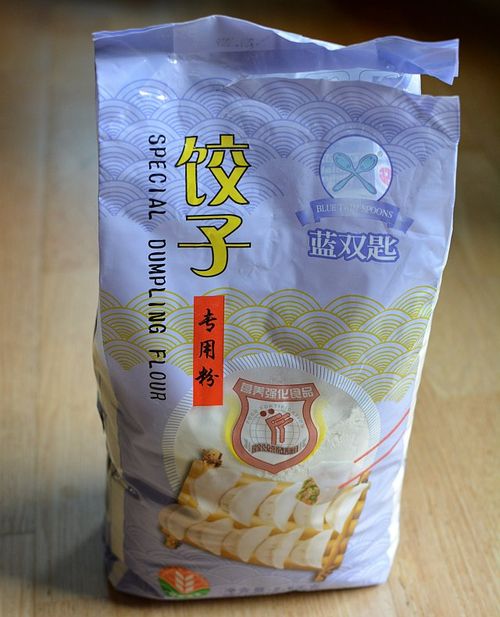
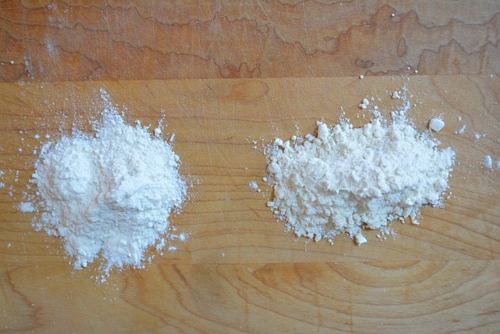
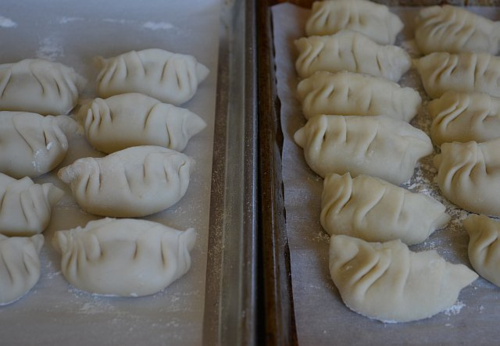
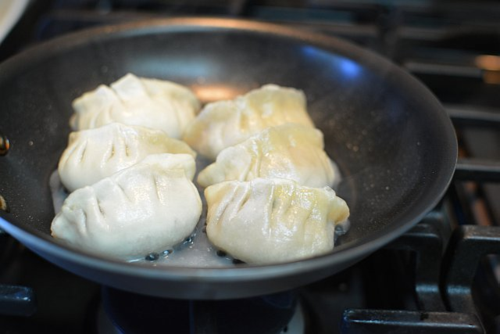
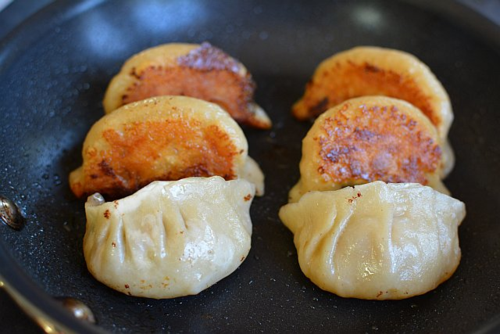




Brian says
Very interesting read. Local flours do make a difference it would seem.
When I was in London, I had tea and scones at Harrods - a very touristy thing to do. the Harrods scones looked like your typical currant scones, but the texture was unlike any pastry I've ever had. They literally did "melt in your mouth". They weren't tough, baking powder-y, or dry. All I can think of is that they use some sort of special flour. I'm not a baker, so I can't be sure, but that's my guess.
In Mexico City, the pan dulce were also so tender and fresh. Like the scones, there was something completely different about them. The ones I have here in the US are typically pretty tough and always dry.
Suzette says
My friend shared her white bread recipe with me, and she noted that she added a few Tbsp of Vital Wheat Gluten when mixing in the flour. It gives it a bit of extra gluten-punch. Curious if adding a bit of that would make a big difference in the elasticity of dumpling dough?
Marilynn Lynn says
Having lived in China for several years, I know that sometimes additives are added to products that are not particularly healthy for us. If the flour had a chemical smell, I'd be leery about using it. I used American flour in Beijing to make my dumplings and you are right, mine never looked quite the same as those in restaurants or friends homes. Marilyn
candice says
Interesting read! I never knew they sell dumpling flour. I'm going to have to see if Sunset Super carries this flour.
Andrea Nguyen says
There's something to be said for tenderness.
Andrea Nguyen says
Yeah, but I don't think you need it if you're using unbleached flour for dumpling skins. Bleached flour would need a little assist for dumpling skins.
Andrea Nguyen says
That was the freaky thing about the flour, Marilyn. Try as they may in mainland China to produce high-quality products, they point of reference is not going to be the same as ours. In rural parts of China, I had fabulous dumplings and bao that were on the rustic side -- not bright white or super duper fluffy. Thanks for your insights.
Andrea Nguyen says
Or, any other special flour... 😉
Vickie says
Living in Calif.in eastbay it sometime not easy to head to Asian markets to shop. I always have lot of regular flour around to use and dumplings is family fav. I use it for green onion pancakes lot of other things. But for dim sums I plan ahead when shopping for special flours to use still. Rice flour for chee cheong fun is must have for it.
Diane says
What about sprouted wheat flour? Will this work for dumplings
Mark Toffle says
It sounds like the flour was bromated to make it white and that was the chemical smell you observed. That process is no longer allowed in the USA.
Andrea Nguyen says
I think you nailed it on the head. I recently tried a Korean flour that was much better. The texture was remarkable when I tried it out for Chinese green onion pancakes. I'm still tinkering with the flour, but you may want to look for it:
https://www.vietworldkitchen.com/blog/2018/04/scallion-pancakes-recipe.html
Anon says
If by “not allowed” you mean banned, its use is still allowed in America, but is banned in countries like the UK and Canada. In fact, its use has been banned in China since 2005, so I don’t think it’s the key to what makes Chinese flour different.
It’s true that most commercial flours sold in the US don’t have it and use malted barley as dough conditioner instead, but manufacturers have made the decision to exclude it voluntarily. A lot of bakeries have also chosen to not use it. Although flours aren’t required to be labeled as bromated in every state as long as you don’t see potassium bromate in the ingredient list, you should be fine.
Bleaching flour gives it a more white color. I don’t think I’ve heard of bromating playing a role in that process. If the flour is more white, I would assume it simply means more bleaching.